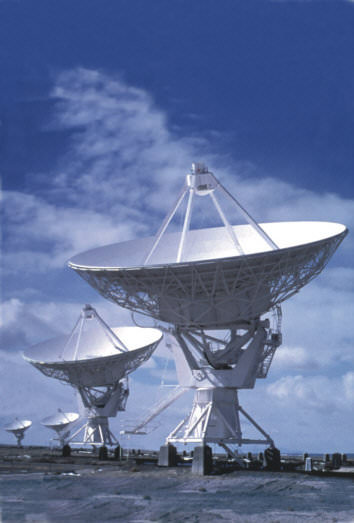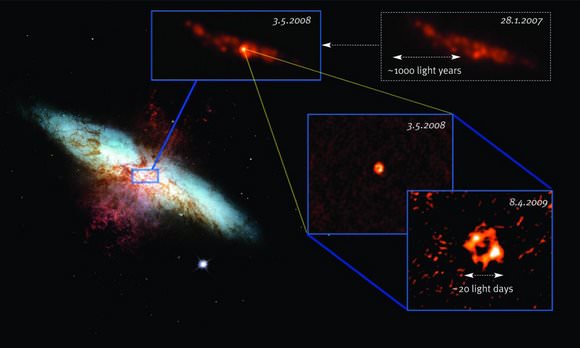[/caption]
Supernovae are extremely luminous explosions of stars and cause bursts of radiation that often outshine an entire galaxy. So, when a supernova exploded last year in a nearby galaxy, why didn’t we see it? Was this an undercover supernova; a top-secret, covert event? Well, kind of. The secret is in the dust.
M82 is an irregular galaxy in a nearby galaxy group located 12 million lightyears from Earth. Despite being smaller than the Milky Way, it harbors a vigorous central starburst in the inner few hundred lightyears. In this stellar factory more stars are presently born than in the entire Milky Way. M82 is often called an ‘exploding galaxy’, because it looks as if being torn apart in optical and infrared images as the result of numerous supernova explosions from massive stars. Many remnants from previous supernovae are seen on radio images of M82 and a new supernova explosion was long overdue. For a quarter of century astronomers kept an eye on M82, hoping to catch a supernova in the act, but with no luck. Astronomers were starting to wonder why the galaxy has been so silent in recent years.
However, a recent explosion actually did occur in M82, and it was the closest supernova in the last five years. But the explosion was shrouded by gas and dust, leaving it invisible to our human eyes, and visible only in radio wavelengths. Astronomers say without the obscuration, this explosion would have been visible even with medium-sized amateur telescopes.
On April 9, 2009, Dr. Andreas Brunthaler from the Max Planck Institute for Radio Astronomy noticed something unusual in the data of M82 taken just the previous day with the Very Large Array (VLA) of the National Radio Astronomy Observatory in New Mexico, USA. “I then looked back into older data we had from March and May last year, and there it was as well, outshining the entire galaxy!” he said. Observations taken before 2008 showed neither pronounced radio nor X-ray emission at the position of this supernova.

On the other hand, observations of M82 taken last year with optical telescopes to search for new supernovae showed no signs of this explosion. Furthermore, the supernova is hidden on ultraviolet and X-ray images. The supernova exploded close to the center of the galaxy in a very dense interstellar environment.
Astronomers began to realize they had perhaps found the clue to the mystery about the long silence of M82. Actually, it hasn’t been silent and perhaps many supernova events have occurred, and are something like “underground explosions”, where the bright flash of light is covered under huge clouds of gas and dust and only radio waves can penetrate this dense material. “This cosmic catastrophe shows that using our radio telescopes we have a front-row seat to observe the otherwise hidden universe”, said Prof. Heino Falcke from Radboud University.
Radio emission can be detected only from core collapse supernovae, where the core of a massive star collapses and produces a black hole or a neutron star. It is produced when the shock wave of the explosion propagates into dense material surrounding the star, usually material that was shed from the massive progenitor star before it exploded.
By combining data from the ten telescopes of the Very Long Baseline Array (VLBA), the VLA, the Green Bank Telescope in the USA, and the Effelsberg 100m telescope in Germany, using the technique of Very Long Baseline Interferometry (VLBI), the team was able to produce images that show a ring-like structure expanding at more than 40 million km/h or 4% of the speed of light, typical for supernovae. “By extrapolating this expansion back in time, we can estimate the explosion date. Our current data indicate that the star exploded in late January or early February 2008,” said Brunthaler.
Only three months after the explosion, the ring was already 650 times larger than Earth’s orbit around the Sun. It takes the extremely sharp view of VLBI observations to resolve this structure which is as large as a 1 Euro coin seen from a distance of 13.000 km.
The asymmetric appearance of the supernova on the VLBI images indicates also that either the explosion was highly asymmetric or the surrounding material unevenly distributed. “Using the super sharp vision of VLBI we can follow the supernova expanding into the dense interstellar medium of M82 over the coming years and gain more insight on it and the explosion itself,” said Prof. Karl Menten, director at the MPIfR.
Discoveries like this supernova will be routine with the next generation of radio telescopes, such as the Low Frequency Array (LOFAR) which is currently under construction in Europe, the Allen Telescope Array (ATA) in the USA, or the planned Square Kilometer Array (SKA). These will have the capability to observe large parts of the sky continuously.
Lead image description: Zooming into the center of the galaxy M82, one of the nearest starburst galaxies at a distance of only 12 Million light years. The left image, taken with the Hubble Space Telescope (HST), shows the body of the galaxy in blue and hydrogen gas breaking out from the central starburst in red. The VLA image (top left) clearly shows the supernova (SN 2008iz), taken in May 2008. The high-resolution VLBI images (lower right) shows an expanding shell at the scale of a few light days and proves the transient source as the result of a supernova explosion in M82.
Graphics: Milde Science Communication, HST Image: /NASA, ESA, and The Hubble Heritage Team (STScI/AURA); Radio Images: A. Brunthaler, MPIfR. (Click image for higher resolution).


“The asymmetric appearance of the supernova on the VLBI images indicates also that either the explosion was highly asymmetric or the surrounding material unevenly distributed.”
I’d be voting for uneven distribution of the surrounding interstellar material….
Or probably both. Although a supernova is such a high-energetic event, it depends also on the little things. If the neutron star (presuming one was created) didn’t oscillate isotropically (little variation would do) the explosion would be asymmetric. It is even possible that the neutron star has been ejected with high speed from the explosion. I think such high speed neutron stars have been observed in the Milky Way – so it seems possible.
Indeed, DrFlimmer, given the chaotic internal dynamics deep within this starburst galaxy, I could see where both asymmetric detonation and interaction with the ISM could both be simultaneously invoked, imo.